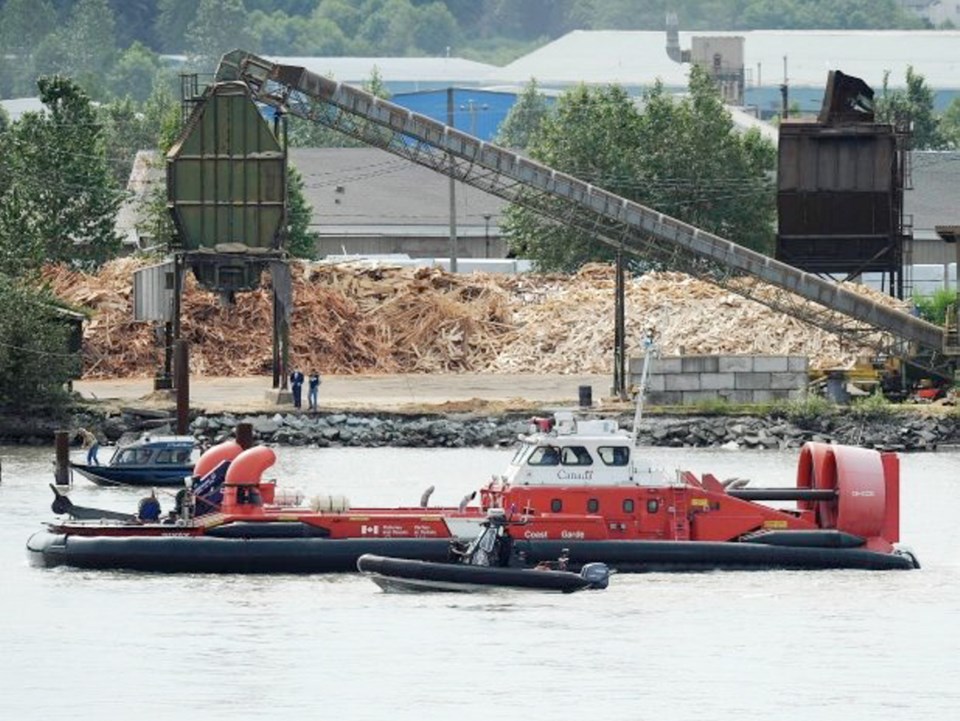It’s shaping up to be a disastrous year for B.C.’s tugboat industry with the sinking of its sixth tug Monday, the third lost this month.
Clinton Rebeiro, a nautical investigator with the Transportation Safety Board of Canada (TSB), said the coast guard received word Monday morning that the 18-metre tug Harken 10, destined for Shelter Island Marina and Boatyard in Richmond, had sunk in the Strait of Georgia around 5 a.m. near Sand Heads, north of the Tsawwassen Ferry Terminal.
Its two-person crew managed to safely abandon ship using a smaller boat they were towing, but more details weren’t yet available, Rebeiro said Monday.
“We’re going to assess the incident and gather data,” and speak with the crew Tuesday, he said.
Tim MacKenzie, president of Port Coquitlam-based Harken Towing, said he’d chartered the Harken 10 to Jones Marine Services, whose president, Daryl Jones, was away from the office Monday and unavailable for comment.
MacKenzie described the Harken 10 as a “great” and “safe” tug, and said it was “out of the ordinary” for such a boat to go down.
“It’s a very important boat to us, it was my biggest boat,” he said, adding the ship was running without a barge in tow when it sank.
“These boats, they just don’t sink, they shouldn’t sink. I work on them, my kid works on them and my grandkid’s working them, so if I thought for one second they weren’t safe, I sure as hell wouldn’t have my family members on them.”
MacKenzie said the loss of three tugs this month could be chalked up to “a run of bad luck,” unlike anything he’s seen in his 50 years in the industry.
“It’s kind of frustrating,” he said. “It doesn’t look nice when you have these things happen in a sequence of events. It kind of puts a black cloud over the boats that shouldn’t be there.”
Rebeiro said the TSB has drafted a report following a probe into the March 18 sinking of one tug, but reports for two other incidents earlier this year weren’t deemed necessary because safety deficiencies weren’t found.
“The last three, we’re still gathering information, so we’re still finding out what happened — we can’t draw any conclusions right now,” he said.
On Sept. 22, around 8:20 p.m., the 10-m Sea Imp X girded and sank in the North Arm of the Fraser River.
Its crew managed to abandon ship, but the vessel sustained massive damage during the incident, which industry sources said was caused by a deadhead jamming into one of its propellers, stopping it dead in the water as the barge in tow dragged it sideways and under.
Three days before the Harken 10 sank, MacKenzie told The Province deadheads in the North Arm had been an ongoing concern for tug operators and crews.
On Sept. 11, around 6 p.m., the crew of the 15-m Ocean Gordon was rescued by the coast guard after the tug capsized and sank in shallow waters while towing a gravel barge in Vancouver Harbour.
Capt. Phillip Nelson, president of the Council of Marine Carriers, which represents about 30 B.C. tug and barge operators, called September’s string of sinkings “perturbing,” adding that his organization is grateful no one was injured or killed.
Nelson said he’d spoken with Jones Marine Services about the Harken 10, but also said it’s too early to comment on what went wrong.
“All we know is that the tug started filling up with water and they’re very, very fortunate they were towing a crew boat behind them, so they were able to get off almost without getting their feet wet,” he said.
“We’re concerned that these things have happened but, on the other hand, accidents do happen and generally speaking, the tugboat industry — I won’t say it’s accident-free — but in comparison to other major industries and transportation sectors, we have a pretty good record in respect to safety.”
Nelson said Catherwood Towing, which operated the Sea Imp X, has an “established and well-run and maintained safety managementsystem” with an extensive familiarization program for new deckhands.
“Generally, they’re responsible,” Nelson said of the council’s members. “They follow Transport Canada rules and regulations and the equipment that they operate — the vessels themselves and the cargo that they carry — it’s worth a huge amount of money. No one in their right mind would give the responsibility for that to someone who doesn’t have the necessary expertise and qualifications.”
TUG BOAT FACTS
1. Tugs vary in size and complexity and therefore prices range widely. A small “yarder” may cost about $1 million to build, whereas a large multi-engined, ship-docking tug can cost more than $4 million.
2. Tugs vary between four or five tons to as much as 1,000 tons, although ships of that size are fairly uncommon. The average tug is below 150 tons.
— Source: Council of Marine Carriers
TUGS SUNK IN 2015
Sept. 28 — Harken 19, southern Georgia Strait
Sept. 22 — Sea Imp X, North Arm of the Fraser River
Sept. 11 — Ocean Gordon, Vancouver harbour
June 19 — Hodder Ranger, near Port Mellon
March 18 — Syringa, near Sechelt
March 15 — Log Baron, near Cape Caution
— Source: TSB
NUMBER OF TUGS SUNK VS. TUG SHIPPING ACCIDENTS
2015 — 6, 9
2014 — 2, 11
2013 — 2, 15
2012 — 1, 12
2011 — 1, 12
2010 — 2, 13
2009 — 1, 5
2008 — 6, 18
2007 — 1, 17
2006 — 3, 15
— Source: TSB



